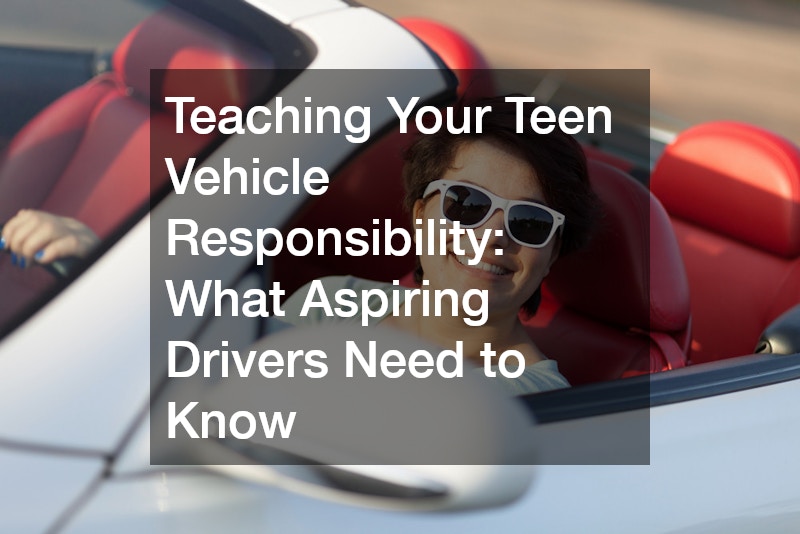Helping teens become safe, confident, and responsible drivers is one of the most important tasks for any parent or guardian. While passing the written test and acing the road exam are major milestones, they’re only part of the journey. True driving independence comes from understanding the everyday responsibilities that come with owning and maintaining a vehicle. From managing basic upkeep to staying compliant with regulations, aspiring drivers need guidance that prepares them for real-world driving scenarios. This process isn’t just about learning how to handle a car—it’s about building habits that lead to long-term safety and financial awareness.
Young drivers often underestimate just how much effort and planning go into keeping a vehicle running smoothly. Teens need to learn how to take ownership of their vehicle, from making sure it’s legally ready for the road to understanding what to do when things go wrong. Each of these lessons provides an opportunity to build confidence, independence, and a stronger connection to the responsibilities of adulthood.
With these foundational lessons, your teen will be better equipped to take the wheel—both literally and figuratively. The journey starts here, with knowledge, guidance, and a clear understanding of what it takes to manage a vehicle responsibly.
Choosing Coverage
One of the most important parts of being a responsible vehicle owner is understanding the role of insurance. While it’s easy to assume that insurance is just a formality, it plays a crucial part in protecting the driver, passengers, and others on the road. Instilling a solid grasp of why coverage matters will help them make informed decisions and act more cautiously behind the wheel.
Teens should understand that not all policies are the same, and that pricing, deductibles, and coverage limits can vary widely. It’s also important to compare options carefully when choosing an auto insurance provider. Walking your teen through the selection process, explaining the costs, and discussing what different coverage types mean, such as liability, comprehensive, or collision, will help them build a working knowledge of financial responsibility.
What aspiring drivers need is a clear picture of the consequences of being uninsured or underinsured. For example, being at fault in an accident without enough coverage could lead to serious legal and financial problems. Teaching your teen to view insurance as a protective tool, rather than a legal requirement, helps shift their mindset from reactive to proactive. This knowledge encourages thoughtful driving habits and builds trust in their ability to make smart decisions when they’re out on the road alone.
Getting It Registered

Registering a vehicle is a legal requirement that often gets overlooked in conversations with young drivers. While it may not be as exciting as learning how to parallel park or navigate a highway, making sure the car is registered is a necessary first step in becoming a responsible car owner. Without proper registration, your teen could face fines, tickets, or even impoundment of the vehicle.
Take the time to explain how vehicle registration works in your state. Each location has different requirements, but most involve submitting paperwork, paying a fee, and receiving official documentation and plates. Walk your teen through how long registration lasts, what forms they need to complete, and how to check expiration dates. Understanding how this process works not only keeps them compliant but also helps them build administrative skills they’ll use throughout life.
Aspiring drivers need to recognize the importance of staying legally responsible. Encouraging them to take ownership of this task, rather than relying on a parent to do it, sets the tone for responsible vehicle ownership. Whether it’s remembering to renew or understanding what paperwork to keep in the car, these seemingly minor details can prevent major headaches down the road.
Filling Up Right
Fueling a car might seem like the simplest task on the list, but it’s also one of the most regular and essential parts of car ownership. Teens must learn how to monitor fuel levels, choose the right type of gas, and manage costs effectively. It’s not just about convenience—it’s about understanding the role that fuel plays in keeping their vehicle running smoothly and efficiently.
Start by showing them how to find out what type of fuel their car requires, whether it’s regular unleaded, premium, or diesel. Misfueling can lead to engine trouble and costly repairs. Let them practice pumping gas under supervision and explain how to keep their fuel tank from running too low, especially in the winter months. These lessons may seem basic, but they help new drivers avoid preventable issues like stalling or being stranded.
What aspiring drivers need is consistency and awareness when it comes to fueling. Encourage your teen to budget for gas, track their mileage, and learn how to spot fuel station scams or unsafe locations. A driver who understands their fuel habits is more likely to take care of the car as a whole.
Tire Care Basics

Tires are one of the most overlooked components of vehicle safety, especially by new drivers. Many teens don’t realize how much the condition of their tires affects everything from braking to fuel efficiency. Teaching tire care is essential for preventing blowouts, reducing wear, and maintaining proper traction in all weather conditions.
Start by helping your teen understand how to check tire pressure using a gauge and how to recognize signs of uneven wear or low tread. Show them where to find the recommended pressure level and explain how over- or under-inflation can impact vehicle performance. It’s also smart to teach them how to rotate tires or have them done on schedule, and when it’s time to replace a set.
What aspiring drivers need is a proactive mindset about tire maintenance. That includes knowing how to change a flat, being aware of seasonal tire options, and understanding how driving habits can wear tires out faster. By giving your teen real hands-on experience and reinforcing the importance of tire safety, you’re helping them develop habits that will protect both them and their passengers.
Finding a Pro
Every driver eventually needs help from a trusted professional when something goes wrong. Whether it’s for routine maintenance or unexpected repairs, knowing where to go—and who to trust—can make a huge difference in cost and quality of service. Helping your teen find a reliable technician early on prepares them to take initiative when problems arise instead of waiting for someone else to handle it.
Explain how to look for a reputable local mechanic by checking online reviews, asking friends or family for recommendations, and verifying certifications. It’s also important to teach your teen to ask questions. This kind of communication can prevent upselling and ensure they’re getting only the services they need.
What aspiring drivers need is confidence when dealing with professionals. Encouraging teens to build a relationship with a local mechanic fosters independence and teaches them to value preventative care. The goal is to equip them with the skills to navigate these situations responsibly.
Fix It Fast

Mechanical issues are inevitable, especially with used or aging vehicles. What matters most is how quickly and wisely a new driver responds to a problem. Delayed repairs can turn a minor issue into a major expense, and failing to recognize a warning sign, like strange noises or dashboard alerts, can lead to dangerous situations. Teaching teens to stay alert and act quickly helps them prevent breakdowns and accidents.
Introduce your teen to the basics of auto repair by explaining how different systems work, such as the engine, brakes, and electrical components. You don’t have to get technical, but helping them recognize signs of trouble is a big step forward. Let them observe or assist during minor fixes like replacing a battery, changing wiper blades, or checking fluids. This kind of exposure builds awareness and makes them more likely to report issues early.
What aspiring drivers need is a sense of urgency and attention to detail when facing car trouble. Show them how to find a trustworthy auto repair shop, how to compare service quotes, and how to know when a vehicle is unsafe to drive. With this knowledge, your teen is more likely to handle repairs in a timely and responsible way, turning an inconvenience into a teachable moment.
Understanding Movement
Knowing how a vehicle moves and what affects its motion is critical for safe driving. One area teens tend to overlook is how the vehicle’s physical contact with the road directly impacts control and performance. Movement isn’t just about pressing the gas or turning the wheel—it’s about understanding the full system that allows a vehicle to respond predictably and safely under different conditions.
Start by teaching your teen how different components influence movement, especially the wheels. Show them how to inspect their wheels visually, look for signs of rust or cracking, and understand how poor wheel condition can affect the driving experience.
What aspiring drivers need is awareness that smooth, safe motion depends on more than just speed. Whether they’re navigating a tight parking space or driving through heavy rain, healthy wheels provide the control and traction necessary to stay safe. Regular check-ups and knowing when to replace worn components give teens a better chance at avoiding common hazards.
Stop With Confidence

For teen drivers, learning to accelerate is often more exciting than learning how to stop, but knowing how to come to a safe stop is just as important. From unexpected crosswalks to sudden traffic slowdowns, stopping power plays a massive role in preventing accidents. That’s why it’s essential to educate your teen about the systems responsible for effective braking and how to spot problems early.
Begin by discussing common symptoms of brake issues: squealing, grinding, a soft brake pedal, or a vibrating steering wheel when braking. Teach them that brake repair isn’t optional—it’s vital. Help them understand the importance of checking brake pads, fluid levels, and rotors, and knowing when professional service is needed.
What aspiring drivers need is respect for the systems that keep them in control, especially under pressure. Reinforcing this message will empower your teen to notice problems early, seek timely service, and avoid the dangers of brake failure. When they learn how and why brakes matter, they’ll drive more mindfully and cautiously—traits every responsible driver should have.
Smart Shopping
Even responsible teens will face the challenge of managing car costs, and that includes making smart choices about maintenance and parts. Buying brand-new parts isn’t always necessary—or budget-friendly. One of the most valuable lessons a young driver can learn is how to find cost-effective, reliable solutions when it comes to replacing worn components.
Introduce them to the concept of buying used auto parts. Explain how quality doesn’t always mean new, and that trusted salvage yards or reputable resellers can provide parts at a fraction of the cost. Make sure they understand the importance of fit, compatibility, and warranties when purchasing used items. You can even take them along for their first purchase to demystify the process.
What aspiring drivers need is the confidence to make informed decisions about their vehicles without always relying on others. By learning how to shop smartly, weigh their options, and look for value, teens develop resourcefulness. This skill set extends beyond driving and becomes a lifelong asset in handling ownership responsibilities wisely.
Keeping It Current
One of the easiest responsibilities to overlook as a new driver is staying up to date with the legal requirements of car ownership. Administrative tasks may seem minor, but they play a major role in keeping a vehicle street-legal and avoiding fines or disruptions. Teaching your teen to manage these details early on sets them up for a more responsible driving future.
Start by helping them understand the renewal process for essential documents, like license plates and registrations. For example, show them where to check expiration dates, how to access renewal portals, and what paperwork or fees may be required. It’s helpful to explain the consequences of missing a renewal deadline—not just the fines, but also the risk of driving with expired tags.
What aspiring drivers need is a mindset that values preparation and attention to detail. Learning how to manage tag renewal responsibilities on time reinforces a teen’s accountability and strengthens their understanding of what it means to own and operate a vehicle. These small actions build the foundation for confident, informed adult drivers.
Building a Responsible Foundation for Young Drivers
Teaching your teen how to be responsible behind the wheel involves more than handing them a set of keys. It’s about helping them build a long-term mindset of safety, awareness, and personal responsibility. Throughout this guide, we’ve explored a range of foundational lessons that prepare young drivers for the full spectrum of vehicle ownership and operation. From understanding essential maintenance and legal requirements to developing smart habits in everyday driving, each topic plays a role in shaping confident, capable road users.
One of the key takeaways from this discussion is that vehicle responsibility extends far beyond driving itself. These lessons also go hand-in-hand with life skills that serve teens well into adulthood. Teaching them how to seek help from a trusted service provider, make budget-conscious decisions, or stay on top of deadlines reinforces the broader values of responsibility, independence, and critical thinking. With each new task they master, your teen gains confidence and becomes better equipped to handle the demands of modern driving.
Your end goal is to empower teens to take full control of their driving experience. The tools, habits, and knowledge shared in this guide can help set them on the path to being responsible, proactive car owners. As parents and mentors, the best gift we can offer them is the confidence to succeed, one lesson at a time.



















